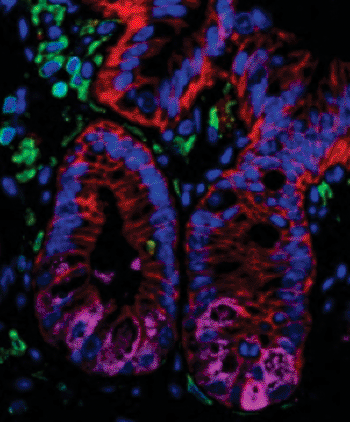Histone Deacetylase 3 Critical in Maintaining Healthy Intestinal Function
By LabMedica International staff writers
Posted on 11 Nov 2013
A team of molecular microbiologists have found that the enzyme HDAC3 (histone deacetylase 3) in intestinal epithelial cells regulates the relationship between commensal bacteria and mammalian intestine physiology.Posted on 11 Nov 2013
Histones play a critical role in transcriptional regulation, cell cycle progression, and developmental events. Histone acetylation and deacetylation alter chromosome structure and affect transcription factor access to DNA. HDAC3 represses transcription when tethered to a promoter. This protein can also down-regulate p53 function and thus modulate cell growth and apoptosis. The HDAC3 gene is regarded as a potential tumor suppressor gene.

Image: A histologic section of intestinal tissue isolated from healthy mice stained to visualize intestinal epithelial cells (EpCAM, red), including Paneth cells (lysozyme, magenta), as well as immune cells (CD45, green) Nuclei are stained with DAPI (blue) (Photo courtesy of the University of Pennsylvania).
Investigators at the University of Pennsylvania (Philadelphia, USA) examined the role of HDAC3 in maintaining a healthy symbiotic relationship between the intestinal tract and its mixture of commensal bacteria—the microbiota.
To this end, the investigators genetically engineered a line of mice that lacked HDAC3 specifically in the intestinal epithelium. They found that these animals exhibited extensive dysregulation of gene expression, including decreased basal expression of genes associated with antimicrobial defense. When housed under normal laboratory conditions, the genetically engineered mice demonstrated loss of Paneth cells (which secrete antibacterial compounds into the lumen of the intestinal gland, thereby contributing to maintenance of the gastrointestinal barrier), impaired gastrointestinal function, and alterations in the composition of intestinal commensal bacteria. In addition, HDAC3-deficient mice showed significantly increased susceptibility to intestinal damage and inflammation.
Normal gastrointestinal behavior was maintained if the HDAC3-deficient mice were raised in a germ-free environment so that they lacked commensal bacteria.
“There is a fundamental change in the relationship between commensal bacteria and their mammalian hosts following deletion of HDAC3 in the intestine,” said senior author Dr. David Artis, associate professor of microbiology at the University of Pennsylvania. “The implication is that intestinal expression of HDAC3 is an essential component of how mammals regulate the relationship between commensal bacteria and normal, healthy intestinal function. Obviously more has to be done, but it is clear that this is a pathway that is of significant interest as we continue to define how mammals have coevolved with beneficial microbes.”
The study was published in the November 3, 2013, online edition of the journal Nature.
Related Links:
University of Pennsylvania













